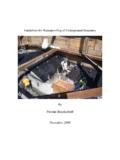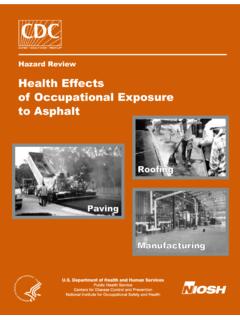Transcription of AS3740 Interpretation of Internal Wet areas Waterproofing ...
1 AS3740 Interpretation of Internal Wet Area Waterproofing 1 AS3740 Interpretation of Internal Wet areas Waterproofing as it applies to Melbourne, Class 1 buildings This document is only a guide to help with installation of Bathroom and Laundry Waterproofing . We recommend a full study of the Australian Standard AS3740 : 2010 be employed. The drawings and references have been supplied by AIW and MBA-NSW publications. Structure Movement and Waterproofing Generally movement in the wall and floor structure is caused by contraction, expansion or settlement. Anticipation that structural movement will occur from frame, masonry and panel movement, particularly at joints, which should be catered for in the design. The Waterproofing should cover the structural movement, preventing water damage to substrate, adjoining walls, or flooring.
2 Providing a secure envelope to protect the wet area. 1. Materials Materials used in the construction and Waterproofing of bathrooms and laundries must be suitable for purpose. Membranes Liquid applied Waterproofing membranes for this review refer to Class ii and Class iii membranes and approved to requirements of AS4858 Liquid applied membranes must be adequately cured for their intended use. Water- resistant Substrates Concrete AS3600, Fibre Cement Sheeting , Water-resistant Plasterboard sheeting AS2588, Masonry AS3700, Flooring grade particle board sheeting and Structural Plywood AS2269 for use on walls and floors to comply with Australian Standards. Water- resistant Surface materials Product surfaces deemed to be water resistant for walls and floors include; Thermosetting laminated sheet , Pre-decorated fibre cement sheeting , Water-resistant flexible sheet (vinyl or linoleum) and tiles used in conjunction with water- resistant Substrates (above), plus Sanitary Grade acrylic wall linings.
3 AS3740 Interpretation of Internal Wet Area Waterproofing 2 Preformed Shower Bases and enclosures Materials used in the manufacture of prefinished shower bases and enclosures must render the finished product waterproof. Sealants, Adhesives and Sheet Fastenings All products need to be compatible with adjacent materials, mould-resistant, waterproof and appropriately flexible. 2. Installation These notes outline the details for installation of waterproof and water-resistant materials in bathrooms and laundries. Falls in Floor Finishes Where required, falls in floor finishes (tiles etc.), outside the shower area, should allow surface water to drain without ponding. Generally the minimum fall to the waste is 1:100 Figures 1 & 2 Shower Floor Falls Showers with a vertical separation between shower area and wet area the minimum fall is 1:100 Shower floors without a vertical separation the minimum fall is 1:80 Figures 1 & 2 Preformed Shower Bases Installation of preformed shower bases need to be adequately supported to prevent distortion or cracking and be sufficiently recessed into the wall to allow the water-resistant surface materials to pass down inside the perimeter rebate.
4 Figure 3 AS3740 Interpretation of Internal Wet Area Waterproofing 3 Edge detail for baths with showers over them Baths with an integral vertical upstand lip along the side of the bath walls require to be recessed to enable the junction to be waterproofed. Baths without an integral edge require full Waterproofing of the walls and floor area around and under the bath. Figures 4, 5, 6 Baths and Spas Installation of baths and spas need to be adequately supported to prevent distortion or cracking and be sufficiently recessed into the wall to allow the water-resistant surface materials to pass down inside the rim. Perimeter Flashing A junction where Waterproofing to Waterproofing surfaces meet, the Waterproofing is to be continuous across the junction and incorporate an appropriate bond breaker.
5 Where the perimeter flashing to wall/floor surfaces they should be continuously sealed (usually with bond breaker), having the vertical leg a minimum of 25mm above the finished floor level (except doorways) and horizontal leg a minimum width of 50mm. A water stop with a vertical leg finishing flush with the finished floor level is to be installed at floor level openings. Protecting water migrating to non-wet areas . Figure 7 Vertical flashing for shower wall junctions Vertical flashing can be external or Internal , with a requirement to terminate a minimum of 1800mm above the finished floor level. Penetrations in Shower areas Typical penetrations like taps, shower nozzles, recess soap holder etc. are to be waterproofed by sealing with proprietary flange system or sealant.
6 Figure 8 Required Floor wastes for wet area Floors With a floor waste, the finished floor is to be constructed so that water flows to the waste without being retained on the surface. Refer Falls in Floor Finishes . Figures 9 & 10 AS3740 Interpretation of Internal Wet Area Waterproofing 4 Shower Area Step Down The highest finished floor level in the shower area is to be stepped down lower than the finished floor level outside the shower. Figure 11 Shower Area Hob Construction Suitable materials for the hob construction. Installation starts with all gaps, joints and intersections of the hob substrate to be made flush before application of the membrane system. Figure 12 Enclosed Shower Area without Hobs or set-down At the extremity of the shower area: Where a shower screen is to be installed a water stop is to be installed with a vertical leg finishing a minimum of 5mm above the finished floor level Where the water stop meets the wall, the junction is to be waterproofed.
7 Figure 13 Shower Area unenclosed Unenclosed showers are to have a water stop installed with the vertical leg finishing flush with the finished surface of the floor, having junctions waterproofed, in two scenarios: When the shower device restricts splashing (shower screen), it is advisable to have a membrane installed below and above the screed to fall. When a shower has no restricting splashing (example disabled shower) the water stop is required to be a minimum of 1500mm from the wall connection of the shower rose. Figures 14 & 15 Bond Breaker Application Installation of bond breakers of liquid applied membranes should be included at all wall/floor, hob/wall, and movement joints where the membrane is bonded to the substrate.
8 AS3740 Interpretation of Internal Wet Area Waterproofing 5 Class II Membranes: (medium extensibility) Either the membrane will not bond to the tape or the tape will have elastic properties similar to the membrane . Minimum bond breaker tape to bridge joint opening up to 5mm is 35mm. Class III Membranes (high extensibility) allow the membrane to have even thickness. Minimum bond breaker tape to bridge joint opening up to 5mm is 12mm Figure 16 Vertical membrane termination The liquid applied membrane is to be applied over the floor substrate and up the vertical face of the wall: Showers with hobs and step downs a minimum height of 150mm above the finished floor level Hobless Showers, a minimum height of 150mm above the finished floor level Termination to Drainage flange The drainage flange is to be installed with the Waterproofing membrane termination into the flange to provide a waterproof connection.
9 Figures 9 & 10 Termination to Drainage Channel The waterproof drainage should be continuous, with the liquid applied membrane covering the drainage channel, with a minimum horizontal termination of 50mm on the horizontal surface. Figures 9 & 10 Inspection and Acceptance Test On completion of the installation of a membrane system, inspection and acceptance testing must be conducted. In addition to the visual inspection, either the dry film thickness test (DFT) by non-destructive means or a controlled water test for a minimum of 24 hours duration is required. Figure 17 AS3740 Interpretation of Internal Wet Area Waterproofing 6 Figure 1 AS3740 Interpretation of Internal Wet Area Waterproofing 7 Hobless Shower Hob Shower Figure 2 AS3740 Interpretation of Internal Wet Area Waterproofing 8 Figure 3 AS3740 Interpretation of Internal Wet Area Waterproofing 9 Figure 4 AS3740 Interpretation of Internal Wet Area Waterproofing 10 Figure 5 AS3740 Interpretation of Internal Wet Area Waterproofing 11 Figure 6 AS3740 Interpretation of Internal Wet Area Waterproofing 12 Figure 7 AS3740 Interpretation of Internal Wet Area Waterproofing 13 Figure 8 AS3740 Interpretation of Internal Wet Area Waterproofing 14 Figure 9 AS3740
10 Interpretation of Internal Wet Area Waterproofing 15 Figure 10 AS3740 Interpretation of Internal Wet Area Waterproofing 16 Figure 11 AS3740 Interpretation of Internal Wet Area Waterproofing 17 Figure 12 AS3740 Interpretation of Internal Wet Area Waterproofing 18 Figure 13 AS3740 Interpretation of Internal Wet Area Waterproofing 19 Figure 14 AS3740 Interpretation of Internal Wet Area Waterproofing 20 Figure 15 AS3740 Interpretation of Internal Wet Area Waterproofing 21 Figure 16 AS3740 Interpretation of Internal Wet Area Waterproofing 22 Figure 17




